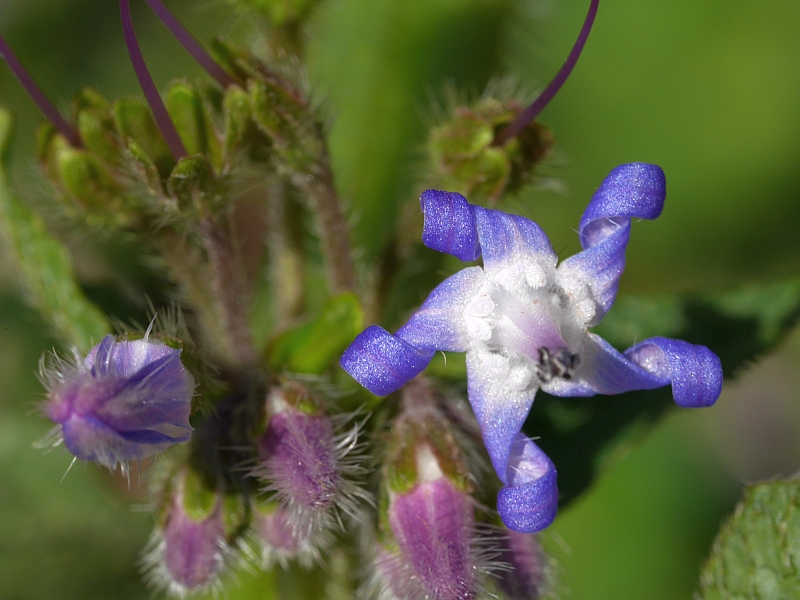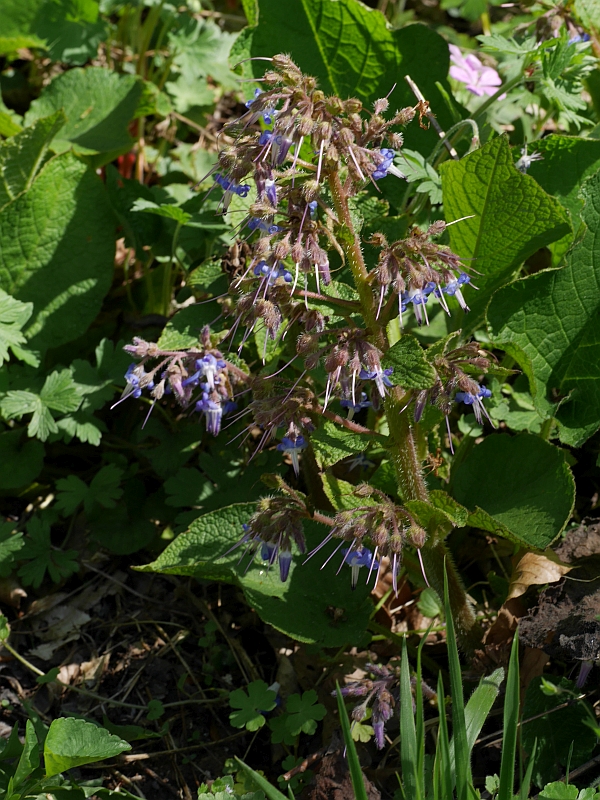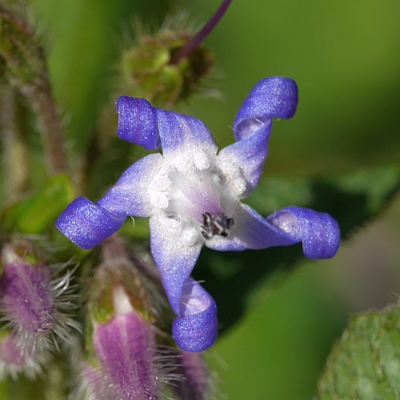When I was in the Strandja Nature Park in Bulgaria last month, I was introduced to a new for me woodland edimental groundcover bee-friendly plant, Trachystemon orientalis. It clearly has potential as a Forest Garden plant, where it is hardy, although it could potentially be invasive. It is missed in major works on edible plants such as Plants for a Future and Cornucopia II! In the UK, it is recognized as particularly valuable as a ground cover as it tolerates very dry conditions in summer!
Here’s a few pictures of it taken in woodland in the Strandja Nature Park in April 2015. Before I had known of it’s edibility I had also taken one picture of it just last December at Hilliers Aboretum in Hampshire, UK. As fate would have it, I’m giving a talk there tomorrow!!
Wikipedia says: Abraham-Isaac-Jacob , Early-flowering or Oriental Borage, is a perennial herb of the family Boraginaceae. It is frequently grown as an ornamental for its early blue-violet flowers and large leaves. It quickly spreads to provide a dense groundcover. Trachystemon is derived from the Greek trachys, meaning rough, and stemon, a stamen. The species name orientalis means eastern or from the orient, and is a reference to the native distribution of this species. Trachystemon orientalis is endemic to southeastern Europe and western Asia.
Trachystemon orientalis has naturalised widely in the UK and other European countries, like Germany, where it is grown by Turkish immigrants.
http://bsbi.org/maps/#taxonid=2cd4p9h.p8r&taxon=Trachystemon orientalis
I am grateful to one of my new friends from Bulgaria, Maria Tariyska and also Ivan Kamburov for informing me and for explaining how it’s used in Bulgaria:
The most famous use of Trachystemon orientalis in Strandja is connected with the preparation of river fish (fish in lopushka – the name of the plant in Strandja). Small river fish with spices in the leaves of Trachystenom orientalis are baked while buried in the embers (almost extinct). Young stems with flowers of Trachystemon orientalis smothered in fat. Eggs eventually may be added at the end. It is believed that Trachystemon orientalis and nettles are one of the most nutritious foods. We (Ivan and me) put flowers and young shoots in our salads.
An article from internet – http://www.plantspeople.com/oriental-borage-trachystemon-orientalis
“Farmers bringing cultivated crops and wild harvests to the Black Sea farmer’s market in Kasimpaşa Istanbul provide a glimpse of north Anatolian landscapes. In March many market stalls had large heaps and sacks of Oriental Borage (Trachystemon orientalis) for sale by the kg. It is a native Turkish plant that grows in deciduous forests, on shady riverbanks and damp ravines. On the edge of the Black sea in north Anatolia high rainfall throughout the year creates a damp climate, very much a contrast to the Aegean and Mediterranean coasts that have scorching hot and dry summers, and to the concrete dominated landscapes of cities. Oriental borage is used as a vegetable and is also considered to have medicinal properties in Turkey. Outside of its natural distribution from east Bulgaria to west Caucasus, that includes Turkey, Oriental borage can occasionally be seen grown as an ornamental garden plant. As an early blooming and nectar yielding plant it is good for bees. It also grows vigorously – perhaps best demonstrated by its abundance on markets – and tolerance of shade makes it a good groundcover plant. In Germany Turkish immigrants cultivate Oriental borage as a crop since it is not a native species in Germany and it is not available on the market. However it has the potential to become naturalised in Germany as it persists in ruderal places if it is not collected and used. This introduction of Oriental borage as a crop species in Germany is relatively recent, it is a neo-hemerophyte. Other members of the Boraginaceae family are known to contain pyrrolizide alkaloids, which may also be present in Oriental borage. Consequently there may be health concerns over consuming this plant in large quantities.”
See also http://www.botanicalgarden.ubc.ca/potd/2008/04/trachystemon_orientalis.php






Stephen,
it is quite invasive over here, every year I pull out loads of new shoots all around the plants, but it’s not so drought tolerant, al least not during last spring, leaves became brown and dry. Some sources claim that there’s some toxicity in the leaves, here’s one:
https://www.accessdata.fda.gov/scripts/plantox/detail.cfm?id=4551
Greetings, and good bird video-hunting :-)
Good to hear from you! Thanks for the warning…I would suspect it’s safe to eat as it’s only available over a short period. Similar to comfrey (Symphytum).
Hi Stephen,
We call this deve pancari (camel’s beet) in the black sea region of Turkey. We first cut off the leaves, boil the remainders and then stiry fry the boiled stem and flowers with some eggs and onions!
Great post, thanks.
Thanks :)
So you don’t eat the leaves, just everything else?